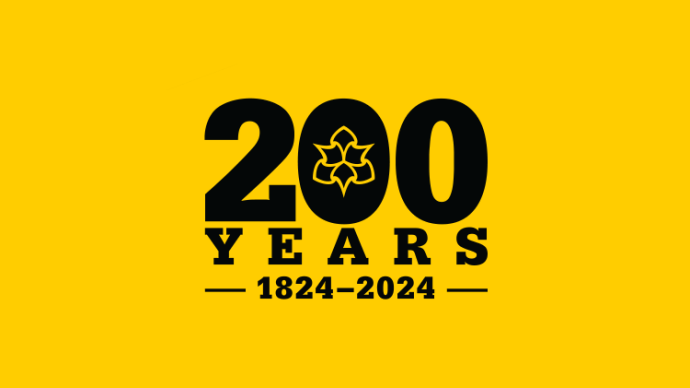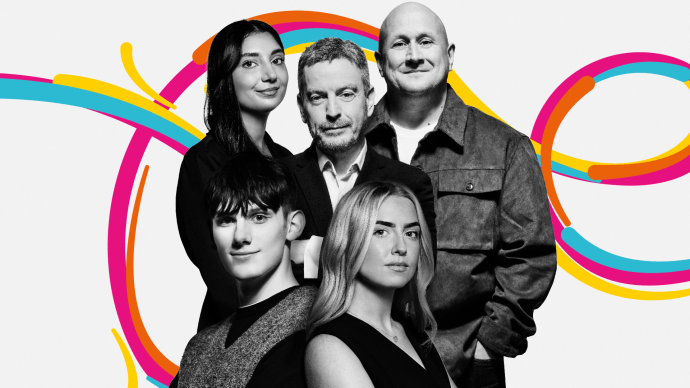Emmy Award-Winning Alumnus, Chris Sayer
Page header image

Standfirst
In this piece, we hear from the motion designer behind the film that has been produced to celebrate 200 years of creative excellence at Manchester Met.
Main story
Emmy Award-winning graduate, Chris Sayer achieved his degree in Illustration with Animation at the University in 1998. He describes himself as ‘passionate about making things move for film, TV and digital.’
Here he talks to us about his continued connection with the city, the University and how it feels to be using his talents to tell the story of Manchester Met’s creative legacy.

How do you feel about making the film to celebrate 200 years of creative excellence at Manchester Met?
It was such an amazing opportunity that I couldn’t pass up. It’s an incredible milestone and an honour to be part of this historical moment.
The archive footage was so incredible to see. It captures people in the studio spaces, crafting, grafting and collaborating – enjoying themselves and connecting.
It is cool to see that in the old footage and it doesn’t seem so far removed from what students are doing today – making friends and having a laugh in the studio space. So yeah, it has been great to get involved with the 200-year celebrations.
What’s the main message or feeling that you want people to take away when they’ve watched the film?
I have an unbelievably warm feeling when I watch the film. I love that we’re seeing changes through time. For me, it’s that feeling of connection and being part of something bigger.
I think a lot of people who have been through an art school would agree that it’s a part of their lifetime that they have incredibly warm feelings towards. The place that they went to, the people they met and the work they created.
So, it is about those three things, people, place and the creative output. There is also something about the emotion of memory and nostalgia.
You are seeing the school through time. The similarity between then and now and how it has changed but hasn’t changed. I think that’s the trigger of emotion.
It’s timeless and everyone can associate with that. They may not have been to university but will have a connection with something like it, the people they work with or went to school with. So, it’s about that sense of community.
Tell us about your time at Manchester Met.
I have amazing, fond memories of being in Manchester. I chose the course because it had an animation aspect to it and as soon as I tried it out, that’s when I fell in love with the medium and that’s why I do it now.
How do you feel about Manchester and your connection to it?
I’d never been to Manchester, and I just fell in love with it. I remember feeling at home in Manchester and enjoying my time there.
Everything was always good. There was always good music and great places to go out with friends.
There were always interesting people coming into lectures. One that stands out to me was by Professor Dan Fearn. He inspired me to be a multidisciplinary designer. Another thing I took from the course was to observe the world, go out and experiment. That was the ethos of the course.
You made some good connections during your studies with people that you then went on to work with?
A big aspect of going to university is the people you meet. Most of the people I work with are people I met at uni.
Like my connection with Jenny Bowers from Peepshow Studio. She was in the year above me and we would chat about our work. I met Pete Mellor at the Royal College of Art. He is another member of Peepshow Collective, a studio I’ve collaborated with consistently since graduating.
It’s interesting how you meet people along the way and then you just become friends and start collaborating.
It wasn’t just the place that I fell in love with. It was the people on the course.
Since graduating from Manchester Met, you have gone on to have a very successful career?
Yeah, it has been an interesting path. I was in my third year at Manchester and knew I wanted to do animation, but I didn’t know how to get into it. And I needed to take my work to the next level.
It was very observational and experimental but needed to be commercially viable. Going to the Royal College of Art (RCA) helped me learn the trade differently and led to my first job with a company called Intro.
I worked there for over 5 years, built up my skill set and it helped me learn a professional level of animation to the point I was ready to go by myself. I set up an animation studio with someone I knew from Manchester Met and that was really successful.
We did lots of cool work and it built my portfolio up. After the business closed, I went freelance and that’s what I have been doing ever since.
I’ve worked with lots of different animation studios and on lots of interesting projects.
It’s meant that I’ve collaborated with lots of people I admire, studios I’ve always admired, and they’ve been my inspiration in the past.
Can you say a little more about your continued connection to the University?
I was watching the news one day seeing images of the new Benzie building, thinking how amazing it looked and wishing I were there. When I went it was a legacy 1960s art school, which was cool, but it had been taken to the next level with the new building.
I was feeling nostalgic about being there and an hour later I got an email from Ian Whadcock who is the Education Lead for Design and a Senior Lecturer for Illustration with Animation. He asked me to get involved with Unit X and since then I have kept in contact and taken part in various projects.
I’ve still got a special connection with this place.
I can’t walk past Manchester Art School and not get goosebumps. I have fond memories of being in Manchester and the University.
Watch the film
See how Chris has captured creative excellence at Manchester Met in his creative film.More stories
Discover more of our creative alumni
-
![Alumni Ryan Gander is sat being interviewed by a female]()
An interview with Ryan Gander
Find out more -
![A profile picture of James who is wearing a black top. You can see the New York skyline through the window behind him.]()
A Q&A with alumnus James Corner
Find out more -
![Simon Stephens]()
Introducing award-winning scriptwriter, Professor Stephens
Find out more -
![A headshot of Liz Newell who is smiling at the camera]()
A Q&A with alumna Elizabeth Newell
Find out more -
![Ibukun Baldwin sat smiling at the camera]()
An interview with Ibukun Baldwin and Professor Alice Kettle
Find out more
About 200 years
Manchester Met celebrates two centuries of driving progress through excellent education and research.
-
![200 years 1824-2024]()
200 years
Find out more -
![Siemens Chief Executive Carl Ennis posing with the firms degree apprentices]()
Driving economic growth
Find out more -
![Two nurses standing together and smiling]()
Transforming health
Find out more -
![A digital image of the university's arts buildings]()
Championing creative excellence
Find out more









